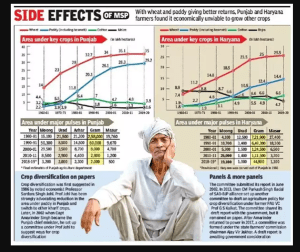THE CONTEXT: The Centre and Punjab government’s initiative of crop diversification scheme to incentivize farmers to shift away from paddy cultivation is a commendable step towards sustainable agriculture. This scheme offers Rs 17,500 per hectare for farmers transitioning to less water-intensive crops during the kharif season, covering up to five hectares per beneficiary. The funding is shared in a 60:40 ratio between the Centre and the Punjab government, with a total budget of Rs 289.87 crore for 2024-25.

THE BOTTLENECKS:
- Profitability Gap: The incentive of Rs 17,500 per hectare is insufficient to bridge the profitability gap between paddy and alternative crops such as pulses, oilseeds, and millets. Paddy farmers receive substantial subsidies, amounting to Rs 38,973 per hectare in Punjab for power, canal water, and fertilizers, making paddy cultivation more profitable than its substitutes.
- Inadequate Duration: The scheme does not specify whether the incentive is for multiple years or just one. A single-year incentive is unlikely to encourage farmers to permanently switch crops, as they would face a significant profit drop after the incentive period ends.
- Assured Procurement: Paddy farmers benefit from assured procurement at Minimum Support Prices (MSP) by state agencies on behalf of the Food Corporation of India (FCI). This assurance is not extended to other crops, increasing market risks for farmers willing to diversify. Effective procurement of alternative crops at MSP by agencies like NAFED is crucial to mitigate these risks.
THE POTENTIALS:
- Environmental and Economic Benefits: Diversifying away from paddy can help conserve groundwater, reduce greenhouse gas emissions, and improve soil health. Paddy requires 20-25 irrigations, whereas pulses, oilseeds, and millets need less than four. The over-exploitation of groundwater in Punjab, where 87% of blocks are categorized as critical, highlights the need for crop diversification.
- Carbon Credits: Transitioning to alternative crops could earn farmers carbon credits, providing an additional income stream. This could open opportunities for developing carbon markets in India, further incentivizing sustainable farming practices.
- Policy Recommendations: To make the scheme successful, the incentive should be increased to at least Rs 35,000 per hectare, and the policy should be operational for a minimum of five years. This approach would not impose additional costs but repurpose existing subsidies towards more sustainable crops. Additionally, ensuring MSP procurement for alternative crops and developing infrastructure for high-value horticulture exports could further support diversification efforts.
THE WAY FORWARD:
- Increase Incentives for Crop Diversification: Paddy cultivation in Punjab and Haryana receives substantial subsidies, amounting to approximately Rs 38,973 per hectare in 2023-24, which makes it significantly more profitable than alternative crops. Increasing the incentive to Rs 35,000 per hectare for switching to less water-intensive crops can help bridge this profitability gap. In Europe, crop diversification practices have provided positive economic results without compromising sustainability, suggesting that well-structured incentives can support diversification.
- Ensure Minimum Support Price (MSP) for Alternative Crops: In Punjab, the Food Corporation of India (FCI) assures the procurement of paddy at MSP, ensuring stable incomes for farmers. Redirecting this support to alternative crops could free up significant funds, approximately Rs 13,150 crore, which can be used to stabilize the market for pulses, oilseeds, and millets. Adequate MSP for non-paddy crops, especially in the initial years, is crucial for successful diversification.
- Develop Infrastructure and Market Access: Studies indicate that access to reliable irrigation, credit, and transportation networks positively influences crop diversification. In Karnataka, for example, infrastructure development has been identified as a critical factor in promoting agricultural growth and diversification. In Africa, improving market access and infrastructure has been linked to increased food security and diversification potential.
- Promote Carbon Credits and Sustainable Practices: Farmers can earn up to 4 carbon credits per hectare by adopting sustainable practices, providing an additional income stream. The global demand for carbon credits is expected to rise significantly, offering lucrative opportunities for farmers engaged in carbon sequestration. The Indian government’s Energy Conservation (Amendment) Bill, 2022 supports carbon credit trading, encouraging farmers to adopt regenerative practices.
- Implement Long-term Policy Reforms: Long-term incentives and support structures are essential for the sustained adoption of diversified cropping patterns. Policies should ensure that farmers receive consistent support for at least five years to build confidence in transitioning from paddy. In Europe, long-term policy support for crop diversification has been crucial in building resilient farming systems.
- Engage Farmer Producer Organizations (FPOs): FPOs can enhance farmers’ market access and bargaining power. Engaging FPOs in aggregating and marketing diversified crops in India has shown potential for improving farmer incomes and market reach. Similar African models have demonstrated collective action’s effectiveness in promoting diversification and enhancing food security.
THE CONCLUSION:
The region can overcome the profitability gap and market risks associated with non-paddy crops by increasing incentives to Rs 35,000 per hectare, ensuring MSP for alternative crops, and developing necessary infrastructure. Promoting carbon credits and engaging Farmer Producer Organizations will further support diversification, as seen in successful international models, enhancing both environmental sustainability and farmer incomes.
UPSC PAST YEAR QUESTIONS:
Q.1 Explain the changes in cropping patterns in India in the context of changes in consumption patterns and marketing conditions. 2023
Q.2 What are the present challenges before crop diversification? How do emerging technologies provide an opportunity for crop diversification? 2021
Q.3 What major factors are responsible for making the rice-wheat system successful? Despite this success, how has this system become a bane in India? 2020
MAINS PRACTICE QUESTION:
Q.1 Discuss the challenges and opportunities associated with agricultural diversification in Punjab and Haryana, focusing on the shift from paddy cultivation to less water-intensive crops.
SOURCE:
Spread the Word
